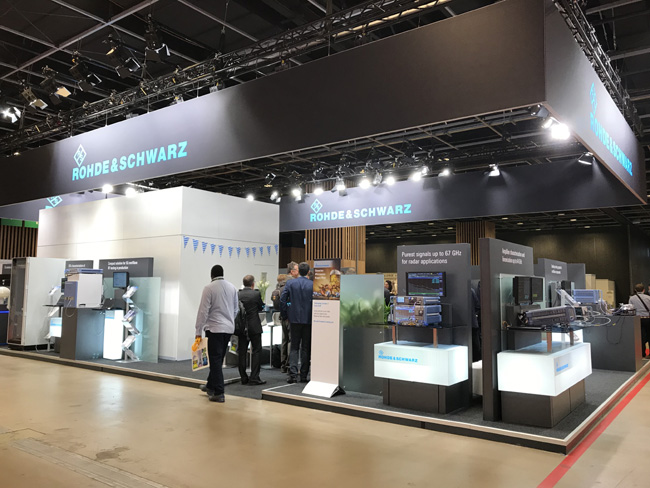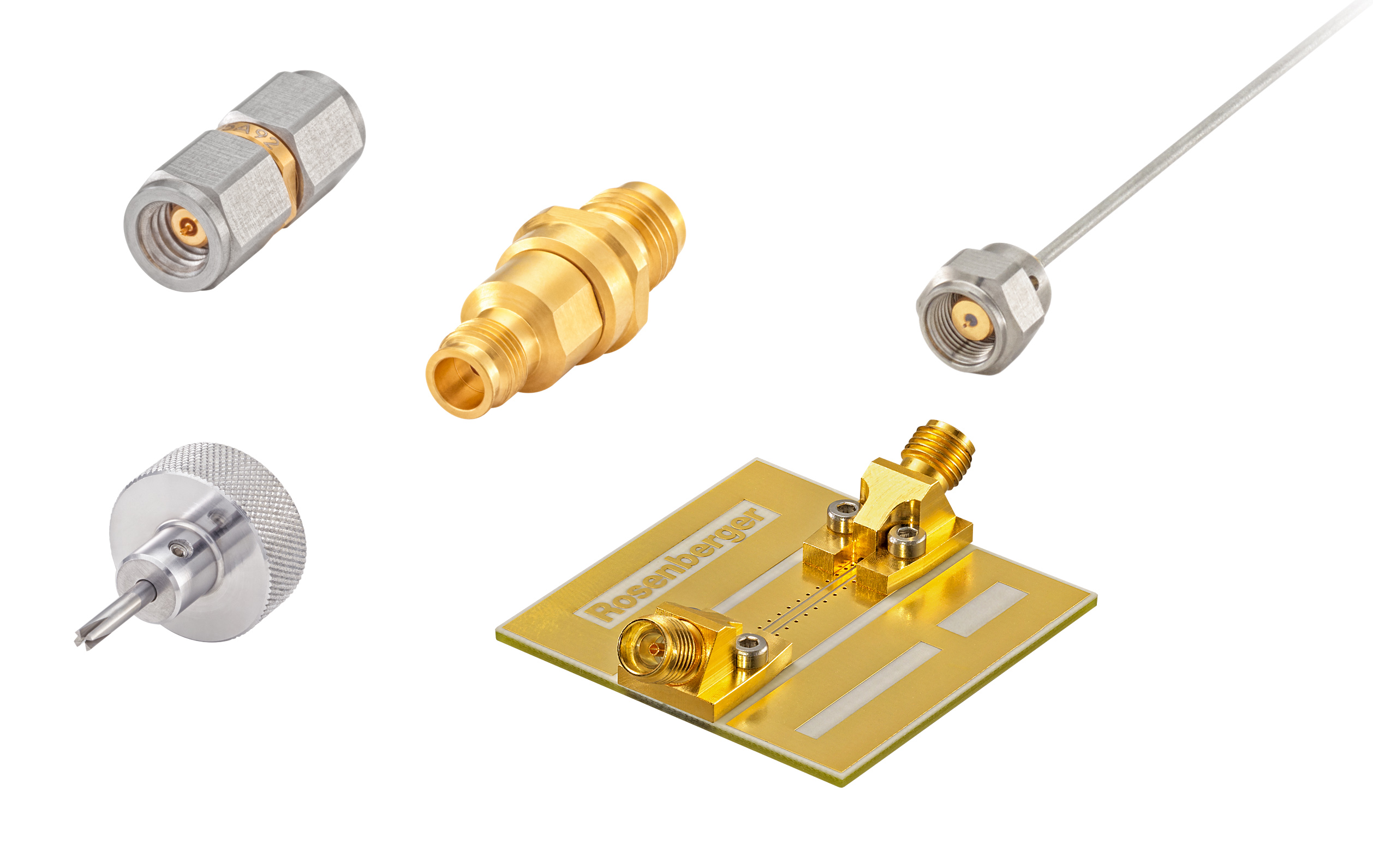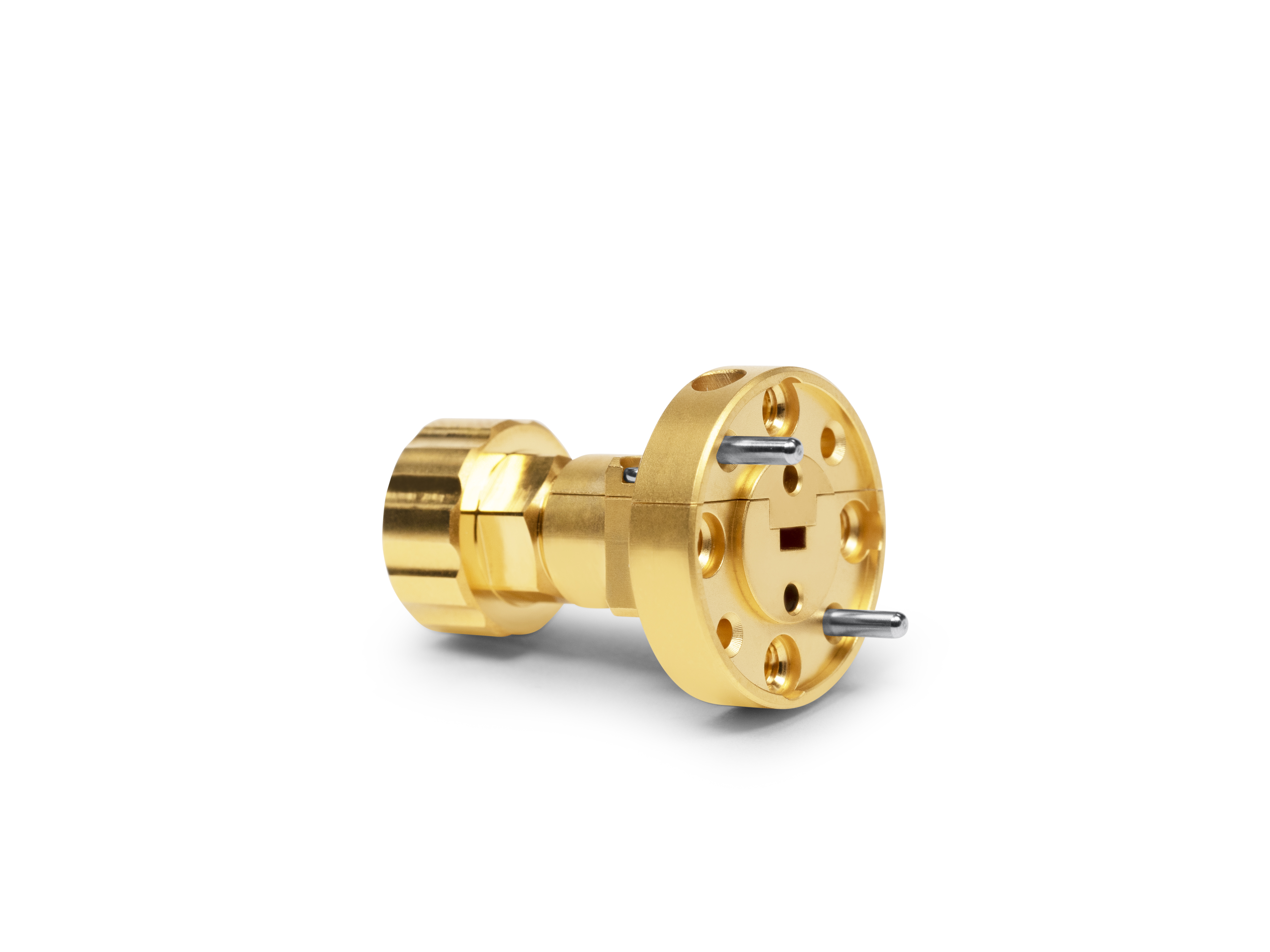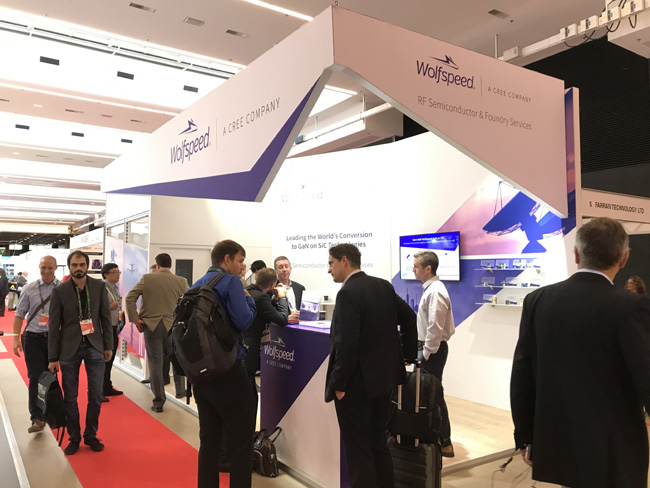OMMIC showcased its latest technologies and to demonstrate the performance of its products, the company teamed up with Keysight Technologies. An advanced setup to characterize the behavior of a device under modulated wideband signal stimulus was on display. The device under test was a CGY2651UH/C1, 10 W GaN/Si power amplifier operating from 37 to 43 GHz, ideal for radar, 5G and space applications. The demonstration aimed to perform error vector magnitude (EVM) and noise power ratio (NPR) measurements in a nonlinear condition.
 Planar Monolithics featured its model SDLVA-18G40G-65-CD-292FF, a Successive Detection Log Video Amplifier (SDLVA) that operates between the 18 to 40 GHz frequency range. It has a dynamic range of 65 dB, log slope of 25 mV / dB and a nominal video bandwidth of 32 MHz. Furthermore, it has been designed using cutting edge GaAs technology which provides stunning performance and reliability in a compact package making it an optimum solution for high speed channelized receiver applications. Size: 2.37" x 1.8" x 0.42."
Planar Monolithics featured its model SDLVA-18G40G-65-CD-292FF, a Successive Detection Log Video Amplifier (SDLVA) that operates between the 18 to 40 GHz frequency range. It has a dynamic range of 65 dB, log slope of 25 mV / dB and a nominal video bandwidth of 32 MHz. Furthermore, it has been designed using cutting edge GaAs technology which provides stunning performance and reliability in a compact package making it an optimum solution for high speed channelized receiver applications. Size: 2.37" x 1.8" x 0.42."
Remcom demonstrated its EM simulation software suite for complete end-to-end design of complex devices and wireless communication systems. Together, the products provide a comprehensive 5G solution, from system and antenna design through performance assessment in realistic, simulated environments and planning for deployment in 5G networks.
RFMW Europe provided product demonstrations and information on Smiths Interconnect innovative passive devices and RF cables assemblies. In addition, products from leading manufacturers such as Ampleon, pSemi, Qorvo, Keysight and others were on display including high-power transistors, MMIC amplifiers, board level switches, filters, attenuators, terminations and other RF components important to design engineers.
 Rohde & Schwarz was featuring many products under the motto “Accelerate design. Maximize performance.” One of the highlights was the R&S SMA100B analog microwave signal generator that is now capable of reaching a frequency of 67 GHz (overrange up to 72 GHz) while offering the purest analog output signals, lowest single sideband phase noise and highest output power with extremely low harmonics. The company also featured amplifier testing for 5G NR in the mmWave range using different techniques to apply crest factor reduction and predistortion. The setup consists of an R&S FSVA3000 signal and spectrum analyzer with an amplifier measurement option in combination with the R&S SMW200A vector signal generator for characterizing amplifiers with any given stimulus. The setup provides all results such as AM/AM conversion, gain compression and EVM from a single measurement.
Rohde & Schwarz was featuring many products under the motto “Accelerate design. Maximize performance.” One of the highlights was the R&S SMA100B analog microwave signal generator that is now capable of reaching a frequency of 67 GHz (overrange up to 72 GHz) while offering the purest analog output signals, lowest single sideband phase noise and highest output power with extremely low harmonics. The company also featured amplifier testing for 5G NR in the mmWave range using different techniques to apply crest factor reduction and predistortion. The setup consists of an R&S FSVA3000 signal and spectrum analyzer with an amplifier measurement option in combination with the R&S SMW200A vector signal generator for characterizing amplifiers with any given stimulus. The setup provides all results such as AM/AM conversion, gain compression and EVM from a single measurement.
The R&S ZNA is a new high-end VNA with a wide range of software features and a unique hardware concept, featuring touch-only operation and a DUT-centric approach. Rohde & Schwarz demonstrated different setups with the R&S ZNA, one for measuring a satellite downconverter and another one with Rohde & Schwarz mmWave converters for the 330 GHz range. The frequency converters are mounted on plates on a rail just as with on-wafer testing. The converters' waveguide flanges can be precisely and reproducibly positioned using the micrometer calipers of the MPI MP80 MicroPositioners. Also featured was the R&S ZNBT40 VNA, a true multiport vector network analyzer with up to 24 integrated test ports and excellent measurement characteristics.
Rohde & Schwarz also showed off a test solution at 77 GHz with the R&S RTP high performance oscilloscope and a harmonic mixer. The R&S RTP provides four coherent channels to measure, for example, the phase difference between the different transmitters. Among the instruments on display at the exhibition was a T&M solution for testing the robustness of automotive radar sensors to interferers. The R&S AREG100A automotive radar echo generator together with the R&S SMB100B RF signal generator form a simple solution for verifying the most advanced radar sensors. Wideband analysis with up to 5 GHz bandwidth of FMCW signals for automotive radar or A&D applications up to 77 GHz will be performed using an R&S FSW85 signal and spectrum analyzer, an R&S RTO2064 oscilloscope as a digitizer and an R&S SMW200A vector signal generator with an R&S SMZ90 frequency multiplier.
Rohde & Schwarz also performed OTA characterization of passive and active RX/TX modules featuring the R&S ATS800R, a unique rack based compact antenna test range antenna test system for measuring EVM and ACLR in FR2. Another setup shows thermal effects diagnosis between –40° and +85° C in an RF OTA chamber, a crucial element of 5G device testing.
 Rosenberger announced a new connector and cable line based on a 1.35 mm connector, which was designed to provide a rugged interconnect for test and measurement of automotive radar and E-Band communications. With a mode-free response to 90 GHz, the 1.35 mm design extends the upper frequency of the 1.85 mm connector and is mechanically more rugged than the 1 mm connector. Rosenberger’s RPC-1.35 portfolio includes connectors; semi-rigid and flexible cable assemblies; various adaptors, including waveguide to coax; and calibration kits.
Rosenberger announced a new connector and cable line based on a 1.35 mm connector, which was designed to provide a rugged interconnect for test and measurement of automotive radar and E-Band communications. With a mode-free response to 90 GHz, the 1.35 mm design extends the upper frequency of the 1.85 mm connector and is mechanically more rugged than the 1 mm connector. Rosenberger’s RPC-1.35 portfolio includes connectors; semi-rigid and flexible cable assemblies; various adaptors, including waveguide to coax; and calibration kits.
 During the event, Smiths Interconnect presented its latest in its Lab-Flex® T Series of flexible coaxial cable assemblies. The T Series cable assemblies are mechanically robust and specifically designed to minimize phase change when subjected to a wide range of operational temperatures. The new cables cover key performance characteristics at various frequency bands from DC to 50 GHz for system applications under extreme temperature and environmental conditions such as radar, test & measurement and space applications. Lab-Flex® T cable assemblies allow for minimum phase change while maintaining excellent return loss. Their special foam dielectric material provides a much lower attenuation than solid PTFE. Precision Connector interfaces meet MIL-STD-348 requirements and are designed for maximum frequency capability.
During the event, Smiths Interconnect presented its latest in its Lab-Flex® T Series of flexible coaxial cable assemblies. The T Series cable assemblies are mechanically robust and specifically designed to minimize phase change when subjected to a wide range of operational temperatures. The new cables cover key performance characteristics at various frequency bands from DC to 50 GHz for system applications under extreme temperature and environmental conditions such as radar, test & measurement and space applications. Lab-Flex® T cable assemblies allow for minimum phase change while maintaining excellent return loss. Their special foam dielectric material provides a much lower attenuation than solid PTFE. Precision Connector interfaces meet MIL-STD-348 requirements and are designed for maximum frequency capability.
For more than 30 years, Spectrum Elektrotechnik has been supplying passive components for the full range of RF/microwave applications, including space. At EuMW, Spectrum featured its foolproof, locking multi-pin connectors for ship, airborne and other high vibration applications. With the HQ series, the cable assemblies in the female shell are hermetic. Spectrum is developing a version with 37 connections. For phase sensitive applications, the company offers manual phase shifters in flat pack and trombone configurations, as well as adapters and connectors with phase adjustment. Spectrum also produces waveguide to coax adapters, either top launch for the best VSWR or end launch for the highest power handling.
 Spinner announced a family of rugged mmWave waveguide to coax adapters designed to simplify the connection from waveguide to a VNA. The adapters convert from V-, E- and W-Band to either a 1.00 or 1.35 mm coaxial connector, providing total coverage from 50 to 90 GHz with the 1.35 mm connector or 110 GHz with the 1.00 mm interface. The adapters have better than 16 dB return loss and lifetimes of at least 3,000 connections.
Spinner announced a family of rugged mmWave waveguide to coax adapters designed to simplify the connection from waveguide to a VNA. The adapters convert from V-, E- and W-Band to either a 1.00 or 1.35 mm coaxial connector, providing total coverage from 50 to 90 GHz with the 1.35 mm connector or 110 GHz with the 1.00 mm interface. The adapters have better than 16 dB return loss and lifetimes of at least 3,000 connections.
Susumu specializes in thin film chip resistors and attenuators for precision applications, from audio to microwave. The resistor is manufactured by sputtering resistive material onto a ceramic substrate, then laser trimming to achieve the required tolerance or attenuation. The resulting surface-mount components work as high as 30 GHz, and some will handle up to 5 W incident power without reliability degradation. The ATS 50 Ω chip attenuators, for example, are configured as either T or π circuits, depending on the selected attenuation, with up to 10 dB available from a single component. The operating frequency range of the ATS series is from DC to 30 GHz, with a tolerance of ±0.25 dB to 10 GHz and ±0.75 dB between 20 and 30 GHz. The operating temperature range is −55°C to +125°C, and the attenuator is rated for 100 mW incident power.
Syrlinks showcased its low power precision clocks (SGTM) and the latest EWOS ovenized quartz oscillators, the perfect solution when RF designers are looking for a smart combination between highly stable frequencies and ultra-low power that are required for stringent battery powered applications.
Teledyne Technologies brought six business units together to show the breadth of its technology and products and how it is a single source for many RF/microwave products. Teledyne MEC featured compact, high power TWTs operating through Q-Band. For classic EW jamming, the company has developed a microwave power module (MPM) combining a solid-state driver with a mini-helix TWT, delivering 100 W CW across 2 to 18 GHz. To ease customers’ design burden, Teledyne can integrate single function components into more complex assemblies, such as combining a PIN diode limiter with a circulator and LNA into a complete receiver assembly with high power protection. Teledyne e2v showed its latest high performance converters (i.e., ADCs and DACs). The ADCs have sampling speeds to 6.4 GSPS with bandwidth to 6 GHz, and the DACs sample up to 8 GSPS with 7.5 GHz bandwidth. Both converter product lines are available “space grade.” Teledyne Storm introduced a 1.35 mm connector, which offers a more rugged alternative to the standard 1.00 mm. The frequency response of the 1.35 mm reaches 90 GHz, which covers the 60 GHz unlicensed band, 77 GHz automotive radar and E-Band communications.
Times Microwave was featuring their Clarity™ Series 18, 26.5, and 40 GHz Test Cables that boasts steel torque, crush and overbend protection with abrasion resistance while not compromising flexibility. The cable is ultra-stable through 40 GHz with exceptionally low attenuation. The design includes an ergonomic, injection molded strain relief and Times’ new, SureGripTM coupling nut to significantly improve the user’s everyday experience. The phase stability is less than 3.5 degrees and is guaranteed up to 50,000 flexes.
TMD Technologies Ltd. (TMD) announced it is celebrating an outstanding 75 years in the microwave and RF field–highlighting its newest, modular intelligent instrumentation amplifiers for EMC, threat simulation and laboratory use, and the company’s latest, innovative RF solid-state amplifiers for cutting-edge mainstream science.
UMS was very active in the technical sessions at EuMW, presenting papers and participating in several panel discussions. In the exhibition, the company promoted its new 0.15 μm GaN on SiC foundry process, GH15, which runs on 100 mm diameter, 70 µm thick SiC substrate wafers. The source-terminated field-plate transistors achieve more than 3 W/mm power density at 30 GHz, biased at 20 V. The process also has dedicated transistor topologies for cold FET applications such as the T/R switches for front-end modules.
Vaunix showcased a variety of recent broadband and multi-port additions to their line of Lab Brick test instruments. Their latest products being introduced at the show included digital signal generators offering high output levels and excellent spectral purity across wide bandwidths up to 20+ GHz, Digital RF step attenuators to 20 GHz offering an ultra-fine 0.1 dB step size (including multi-port devices with up to 8 ports), high speed SPDT and SP4T switches up to 6 GHz, and digital phase shifters to 12 GHz offering excellent phase accuracy and 1 degree phase resolution.
 Virginia Diodes (VDI) demonstrated the WR10 VNAX frequency extension module for VNA measurements in the 75 to 110 GHz band. With this new module, the typical test port output power has increased from +11 to +18 dBm, which improves the system dynamic range to 110 dB minimum, 120 dB typical with 10 Hz bandwidth. David Porterfield, founder of Micro Harmonics and previously a principal at VDI, shared the booth, discussing his company’s family of Faraday rotation isolators covering 50 to 330 GHz.
Virginia Diodes (VDI) demonstrated the WR10 VNAX frequency extension module for VNA measurements in the 75 to 110 GHz band. With this new module, the typical test port output power has increased from +11 to +18 dBm, which improves the system dynamic range to 110 dB minimum, 120 dB typical with 10 Hz bandwidth. David Porterfield, founder of Micro Harmonics and previously a principal at VDI, shared the booth, discussing his company’s family of Faraday rotation isolators covering 50 to 330 GHz.
 WIN Semiconductors celebrated its 20th anniversary with a reception on the exhibition floor. Formed in Taiwan in October 1999, many in the industry were likely skeptical that the company could succeed, even with the “irrational exuberance” of the late 90s internet bubble. Nonetheless, WIN has become the largest pure-play compound semiconductor foundry, expanding from a single wafer fab to three, highly automated fabs producing GaAs HBT and pHEMT, GaN on SiC HEMT and VCSEL devices. WIN has grown faster than the compound semiconductor market and employs nearly 3,000. In addition to celebrating, WIN announced sample kits for its 0.15 μm GaN on SiC process (NP15-00). The process supports linear and saturated PAs operating to 35 GHz. At 29 GHz, the GaN transistor provides 3 W/mm saturated, greater than 50 percent efficiency without harmonic tuning and 13 dB linear gain.
WIN Semiconductors celebrated its 20th anniversary with a reception on the exhibition floor. Formed in Taiwan in October 1999, many in the industry were likely skeptical that the company could succeed, even with the “irrational exuberance” of the late 90s internet bubble. Nonetheless, WIN has become the largest pure-play compound semiconductor foundry, expanding from a single wafer fab to three, highly automated fabs producing GaAs HBT and pHEMT, GaN on SiC HEMT and VCSEL devices. WIN has grown faster than the compound semiconductor market and employs nearly 3,000. In addition to celebrating, WIN announced sample kits for its 0.15 μm GaN on SiC process (NP15-00). The process supports linear and saturated PAs operating to 35 GHz. At 29 GHz, the GaN transistor provides 3 W/mm saturated, greater than 50 percent efficiency without harmonic tuning and 13 dB linear gain.
W. L. Gore & Associates highlighted the company’s full line of GORE® Microwave/RF Assemblies for test and measurement applications at EuMW. All of Gore’s solutions with robust connector options ensure precise, repeatable measurements in small, lightweight and highly flexible designs for longer service life, reduced equipment downtime and lower costs for laboratory, production and field test environments.
 In addition to discussing its portfolio of GaN power transistors and MMICs for defense, satellite and wireless infrastructure, Wolfspeed highlighted its now fully qualified 0.15 μm GaN on SiC foundry process running on its 100 mm fab. Biased at 28 V, the process supports designs to 40 GHz and has demonstrated a median lifetime of 4 million hours at 225°C channel temperature. The company’s parent Cree recently announced plans to build a new 200 mm wafer fab in upstate New York, a $1 billion investment to produce SiC and GaN devices for electric vehicles and 5G infrastructure. Cree will also expand its material growth capacity at its headquarters in Durham, North Carolina.
In addition to discussing its portfolio of GaN power transistors and MMICs for defense, satellite and wireless infrastructure, Wolfspeed highlighted its now fully qualified 0.15 μm GaN on SiC foundry process running on its 100 mm fab. Biased at 28 V, the process supports designs to 40 GHz and has demonstrated a median lifetime of 4 million hours at 225°C channel temperature. The company’s parent Cree recently announced plans to build a new 200 mm wafer fab in upstate New York, a $1 billion investment to produce SiC and GaN devices for electric vehicles and 5G infrastructure. Cree will also expand its material growth capacity at its headquarters in Durham, North Carolina.

